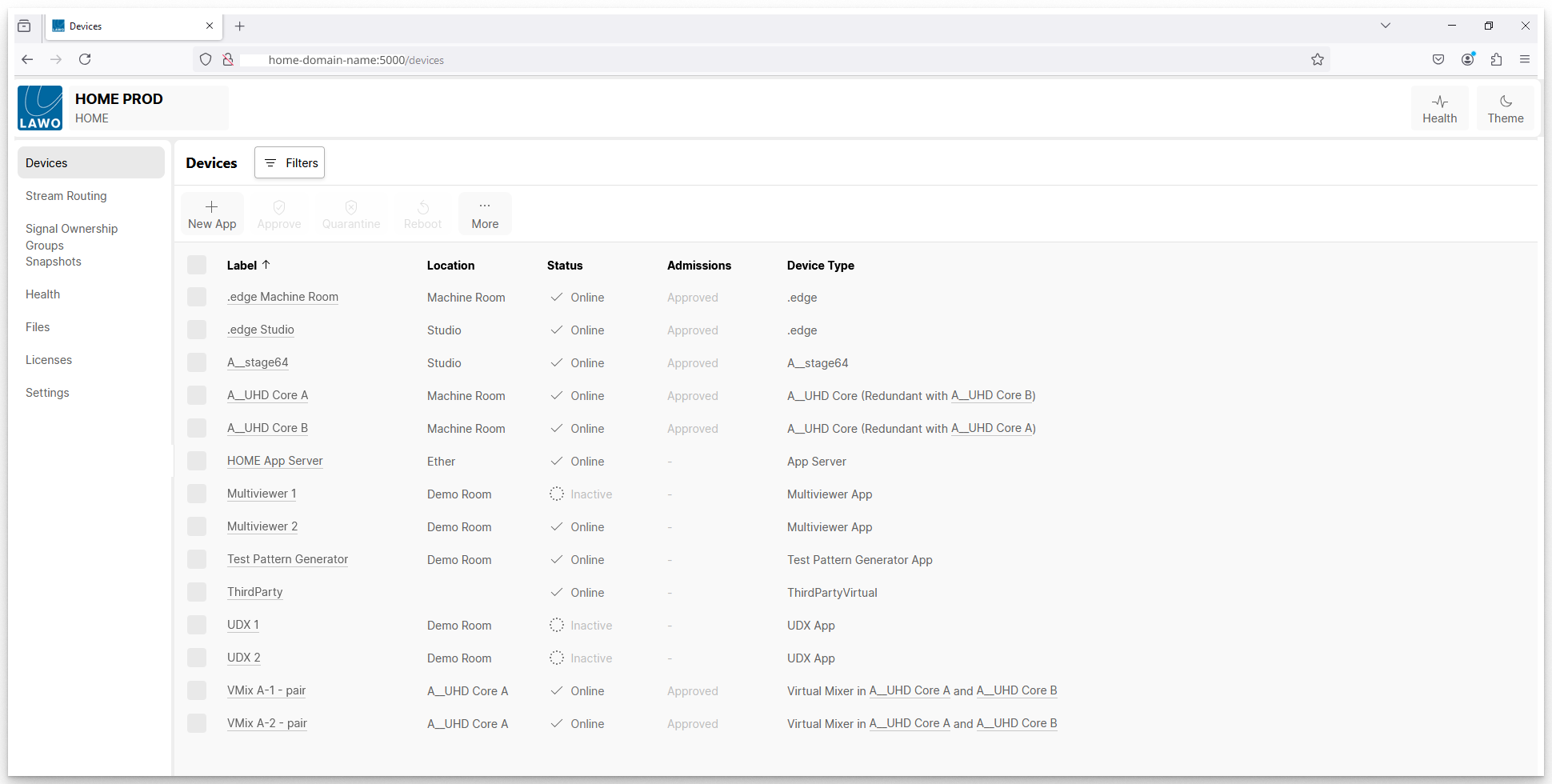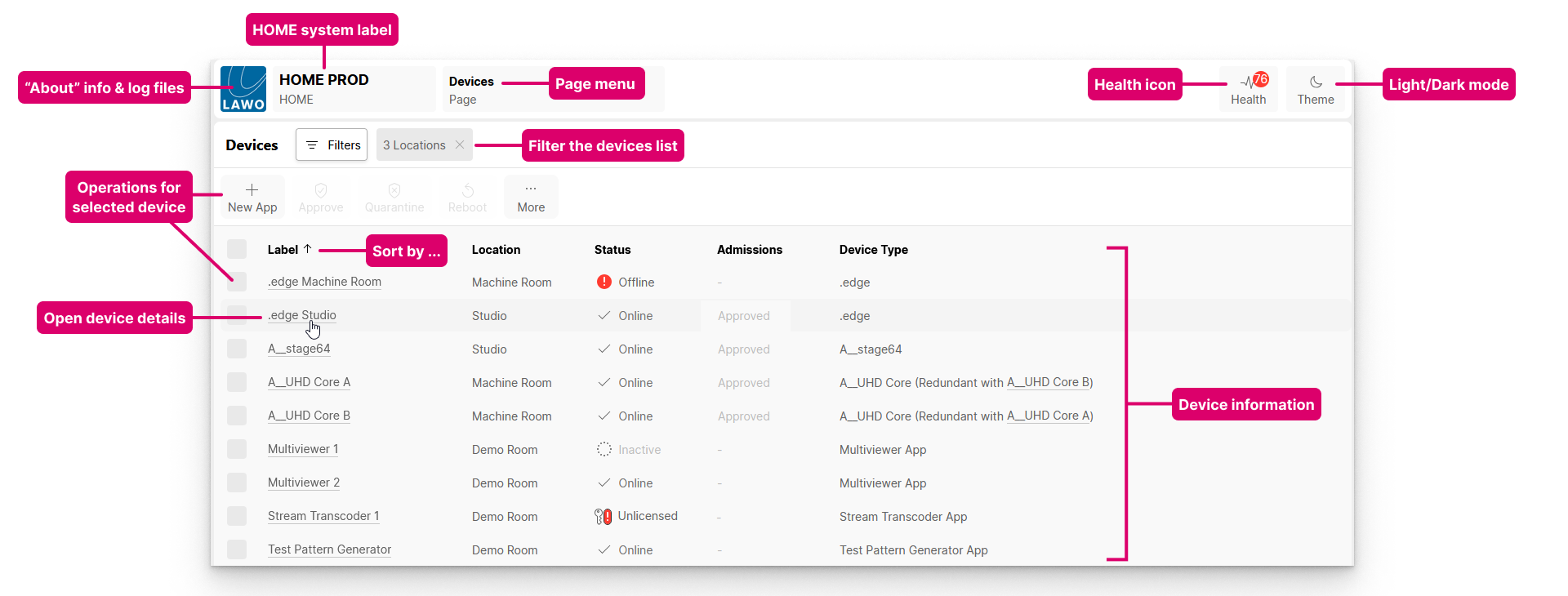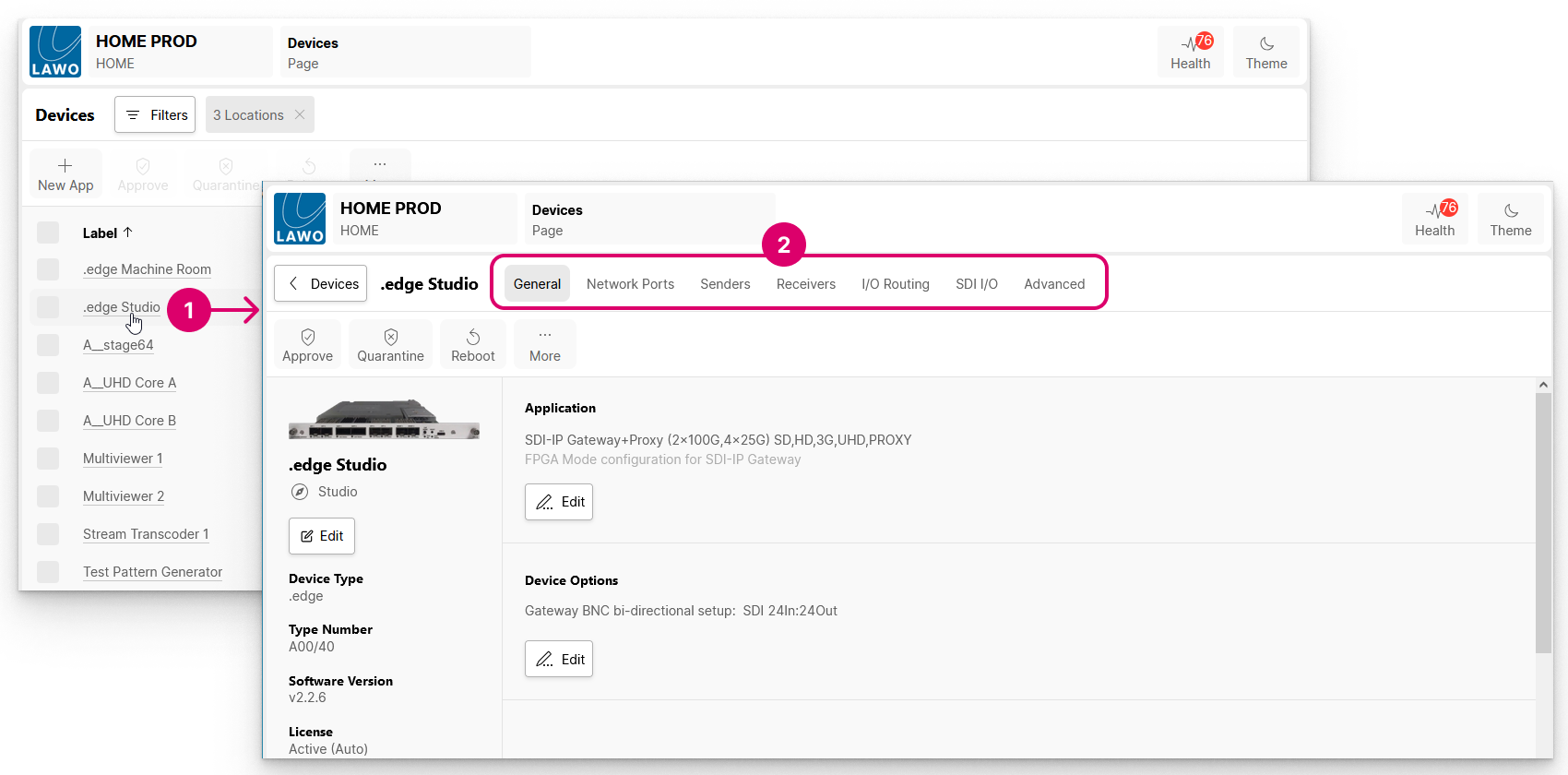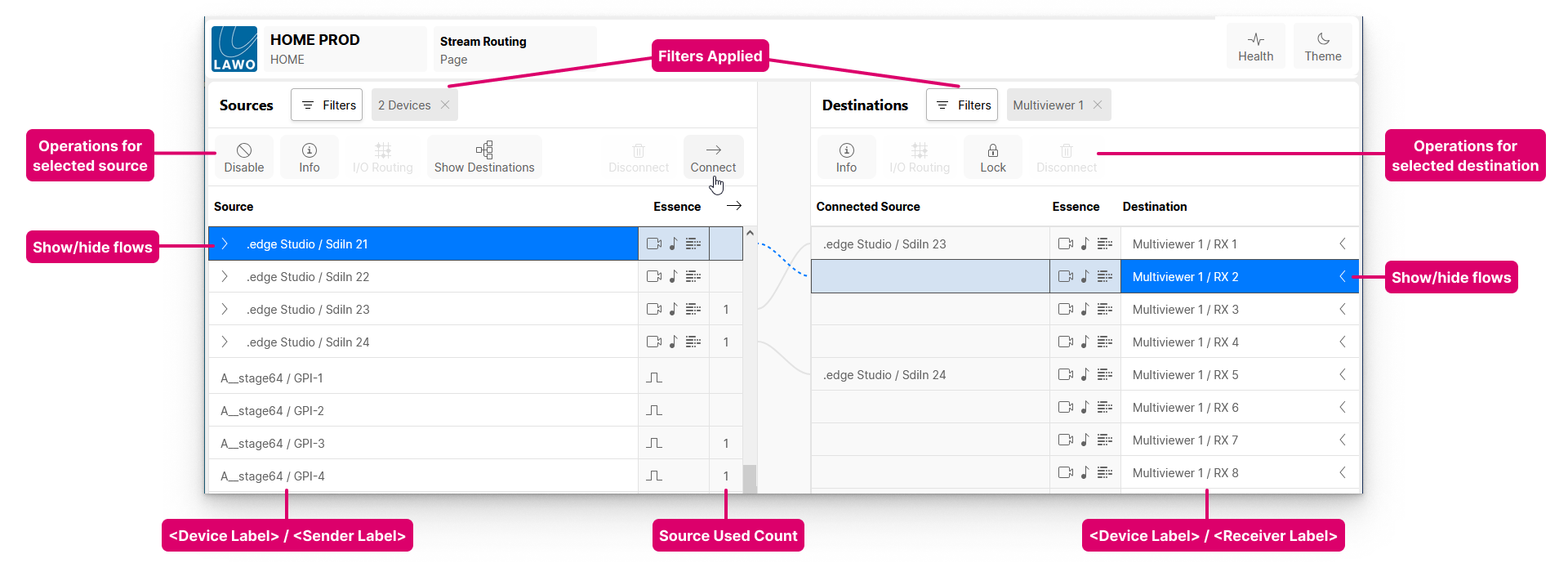.edge - Operating Principles
Before configuring .edge, it is useful to understand how each processing blade is controlled and where its settings are stored.
Remote Control Options
All of the parameters for a processing blade are controlled, via the network, in one of three ways: using HOME, Ember+ or REST API.
As .edge supports native control via Lawo's HOME, this topic assumes that you using HOME as the control interface.
Prerequisites
It is expected that customers will have a HOME system (for device management) and so, once the HOME server(s) are configured, .edge devices are automatically detected by HOME.
You can learn how to configure the processing blade's network interfaces later. For now, it is useful to know that, by default, the MGMT 1 port is configured for DHCP. This means that, once a blade is connected to the HOME network using MGMT 1, its control IP address is assigned automatically (by HOME's DHCP server).
To control a processing blade using HOME, you will need a computer that is installed with a suitable web browser application. The computer must be connected to the same network and subnet as the .edge processing blades and the HOME server(s).
Computer / Browser Requirements
- CPU: Intel i3 or higher
- RAM: 64 MB
- Network Interface Card: operating at 100 or 1000 Base-T
- Screen Resolution: >= 1024 x 786 (FullHD is recommended)
- Web Browser: Microsoft Edge, Google Chrome, Apple Safari or Mozilla Firefox. Please install the latest version of the browser for best performance.
For the best user experience, we recommend running HOME in a browser as used in Lawo's labs (e.g. Google Chrome v100.x or higher).
Open a Connection to HOME
- The IP address must be unique, and set within the same range as that of the HOME servers management NIC(s).
- The subnet masks should be identical.
- A default gateway is required if data packets are to be redirected. For example, if you are connecting via a network switch with Layer 3 routing capability. If redirection is not required, then the default gateway can be left blank.
2. Open your web browser application and type in either http://IP address:5000/ or the domain name of the HOME server followed by port :5000
3. Press Enter.
Following a successful connection, the 'Sign in' screen appears.

If you do not see this screen, then please try the troubleshooting tips (described here).
4. At the 'Sign In' screen, enter the following credentials:
- Username = lawo
- Password = lawo
5. Click on the Sign In button.
Following a successful sign in, the HOME 'Devices' page appears (listing all devices known to HOME).

HOME UI Operation
The example below shows the 'Devices' page on a reduced-width screen. The annotations explain the layout and operation.

The HOME UI can operate in either light or dark mode: click on the Theme icon (top right) to toggle the view.
The Filters button can be used to filter the contents of the list. For example, to view only the devices in a particular location.
For more information about these and other features of HOME, please see HOME - Operating Principles (in the "HOME User Manual").
Identify the .edge Devices
In HOME's 'Devices' list, each .edge processing blade appears as a separate device. So, if you connect all four processing blades (from a single frame), then HOME displays these as four separate entries.
By default, the blades are assigned a default label: .edge_Slot1 to .edge_Slot 4, where slot 1 is the master processing blade (fitted to the highest physical slot in the frame).
- If a processing blade does not appear, or shows as Offline, then check that it is powered and connected to the HOME server network.
- If a processing blade is showing as Quarantined, then it must be approved before you can continue. To learn more, please see Approve or Quarantine a Device (in the HOME - User Manual).
- If you need help identifying each processing blade, then you can use the Identify Hardware function.
- The label and location of each processing blade can be edited using the Edit Device Info function.
Adjust Settings
All of the settings for a processing blade can be viewed and edited from HOME's 'Device Details' tabs. The settings are stored automatically on the processing blade whenever a change is made.
To access the settings:
- Click on the device label (from the main 'Devices' list). The 'Device Details' page opens with the General tab selected.
- Use the menu tabs (at the top of the page) to access settings for the Network Ports, Senders, Receivers, etc.

To return to the main 'Devices' list, click on the < Devices button (to the left of the device label):
The seven menu tabs provide access to the following settings.
General Settings
The General tab includes general information about the processing blade (on the left) and other settings (on the right).
The informational fields (on the left) include the current label and location, Software Version and Serial Number (important for licensing). The Edit button can be used to edit the device label and location. The Identify Hardware function can be used to identify the blade by flashing its Call HOME LED on the front panel.
The settings (on the right) show the Application (FPGA mode) and Device Options (SDI I/O configuration). The Edit buttons can be used to modify the settings (as described in .edge - Operating Mode and .edge - SDI Configuration).
Network Ports
The Network Ports tab lists all of the processing blade's active network ports. From here you can check the status of a port or edit its network settings.
Senders and Receivers
The Senders and Receivers tabs list the processing blade's senders and receivers. These are pre-defined according to the SDI I/O configuration and Audio Router option. For example:
- If the SDI configuration = 24 In:24 Out, then there are 24 SDI senders + 24 SDI receivers, where each one handles multiple flows (that correspond to the SDI input or output): 1x Video, 4x Audio and 1x Meta(data).
- If the Audio Router option is enabled, then there are an additional 64 AudioTx senders and 128 AudioRx receivers. In this instance, each one handles a single Audio flow.
If you select a sender or receiver, then it is possible to adjust the I/O Routing (for the audio streams), edit the streaming parameters or access the SDP data. In addition, the "Show Sidebar" button (on the right) reveals the available properties for the selected sender or receiver. For example, for an audio sender, you can adjust the delay or turn on the test tone.
I/O Routing
The I/O Routing tab can be used to map the audio channels of IP receivers to the audio channels of the IP senders for the Audio Router.
Please note:
- If the Audio Router option is not enabled, then there are no signals to configure.
- If you wish to shuffle the audio channels of an SDI sender or receiver, then this is done from the Senders or Receivers tab (as described here).
SDI I/O
The SDI I/O tab can be switched between SDI Inputs and SDI Outputs. It provides a quick overview of the connections including signal present (for Video and Audio), and which options are enabled (Frame Sync, Ident, Test Pattern, Gearboxing).
The "Show Sidebar" button (on the right) reveals the available properties for the selected input or output. For example, for an SDI input, you can turn on the ident and test pattern, or adjust the gearboxing and input frame sync (if the relevant licenses are active).
Advanced
The Advanced tab provides access to ALL of the available parameters for a processing blade. It is designed for technical users who need access to more advanced settings and informational fields.
Connect and Disconnect Streams

The page lists all available senders (on the left) and receivers (on the right).
- For each source and destination, there are two parts to the label: <device>/<sender> or <device>/<receiver>.
- The icons in the Essence column describe the type of flow: Video, Audio, Metadata and/or GPIO.
- If a source or destination handles more than one flow, then an arrow appears beside its label. Click on the arrow to show (or hide) the individual flows.
- Once a source is connected, a number appears in the "source used" column. This indicates the number of times the source is used. i.e. the number of connections made.
- Once a destination is connected, the "Connected Source" field shows the label of the connected stream.
The following operations are possible:
- Make or break connections - using Connect and Disconnect.
- Interrogate connections - using Show Destinations (for a sender) and the "Connected Source" field (for a receiver).
- Lock connections - using the Lock option (for a receiver).
- Disable sending streams - using Disable (for a sender).
- View (or edit) the stream configuration parameters - via the Info dialog (for a sender or receiver).
- View (or edit) the audio channel mappings - via the I/O Routing page (for a sender or receiver).
To make a connection, select a source (on the left) and a destination (on the right); then click on Connect.
- A dotted (preview) line appears when a connection is prepared.
- This changes to a solid line once the source(s) and destination(s) are connected.
Connections can be made between individual or groups of flows, and for multiple sources and destinations.
For more information, please see HOME - Stream Routing (in the "HOME User Manual").